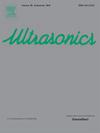High frequency ultrasound 2D array design and fabrication with 3D printed interposers at 200 μm pitch
IF 3.8
2区 物理与天体物理
Q1 ACOUSTICS
引用次数: 0
Abstract
High-frequency 2D ultrasound arrays (10–50 MHz) can adjust the focus position in three-dimensional space to produce highly focused beams and have potential use in ultrasound elastography and ophthalmology applications. However, these applications remain unfulfilled due to the difficulty in realizing the array element pitch requirements of high-frequency ultrasound 2D arrays with existing technologies. In recent years, the rapid development of 3D printing technology has made complex and fine structures possible. By utilizing high-resolution 3D printing technology, we can effectively solve the connection problem between circuits and acoustic modules in the ultrasound 2D array fabrication process, making it possible to fabricate high-frequency ultrasound 2D arrays.
In this work, we demonstrate two alternative fabrication processes for high-frequency 2D ultrasound arrays with a realized pitch of 200 µm and 256 elements per array. The fabricated arrays achieved a yield of 82 % and 75 %, with an average fractional bandwidth of 43 %. The element-to-element variability in bandwidth was 18 %, which reflects the inherent challenges of fine-pitch high-frequency array fabrication. These results highlight the feasibility of scalable fabrication techniques while identifying areas for future optimization.
基于200 μm间距3D打印中间体的高频超声二维阵列设计与制造
高频二维超声阵列(10-50 MHz)可以在三维空间中调节焦点位置,产生高度聚焦的光束,在超声弹性成像和眼科应用中具有潜在的应用前景。然而,由于现有技术难以实现高频超声二维阵列的阵列元素间距要求,这些应用仍未得到满足。近年来,3D打印技术的飞速发展使得复杂精细的结构成为可能。利用高分辨率3D打印技术,可以有效解决超声二维阵列制造过程中电路与声学模块之间的连接问题,使高频超声二维阵列的制造成为可能。在这项工作中,我们展示了两种可选的高频二维超声阵列的制造工艺,实现了200µm的间距和每个阵列256个元件。所制备的阵列的产率分别为82%和75%,平均分数带宽为43%。元件之间的带宽变异性为18%,这反映了细间距高频阵列制造的固有挑战。这些结果突出了可扩展制造技术的可行性,同时确定了未来优化的领域。
本文章由计算机程序翻译,如有差异,请以英文原文为准。
求助全文
约1分钟内获得全文
求助全文
来源期刊

Ultrasonics
医学-核医学
CiteScore
7.60
自引率
19.00%
发文量
186
审稿时长
3.9 months
期刊介绍:
Ultrasonics is the only internationally established journal which covers the entire field of ultrasound research and technology and all its many applications. Ultrasonics contains a variety of sections to keep readers fully informed and up-to-date on the whole spectrum of research and development throughout the world. Ultrasonics publishes papers of exceptional quality and of relevance to both academia and industry. Manuscripts in which ultrasonics is a central issue and not simply an incidental tool or minor issue, are welcomed.
As well as top quality original research papers and review articles by world renowned experts, Ultrasonics also regularly features short communications, a calendar of forthcoming events and special issues dedicated to topical subjects.
 求助内容:
求助内容: 应助结果提醒方式:
应助结果提醒方式:


